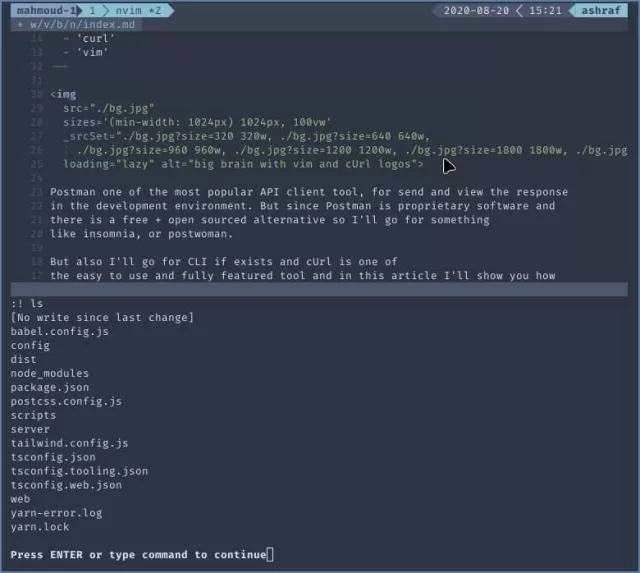
No More postman just use cURL + vim = ❤
Postman one of the most popular API client tool, for send and view the response in the development environment. But since Postman is proprietary software and there is a free + open sourced alternative so I’ll go for something like insomnia, or postwoman.
But also I’ll go for CLI if exists and cURL is one of the easy to use and fully featured tool and in this article I’ll show you how to setup a well-documented api with cURL + vim + git.
How to execute CLI inside your vim editor?
vim is very powerful editor and you can execute an command line
inside it. go to command mode and insert :! <command>
and hit enter.
for example:
:! lswill execute the ls command line and show the content in
pager.
Execute the content of the current file as CLI.
open an empty file inside your vim and write inside it
echo Hello, World! and save it, and then write
:!sh %.
The percent % is refer to the filename so if we run it
with normal bang :! % it will not work because it’s trying
run the file as executable file not the content inside.
so we pass sh before the % to run the
content inside the file via shell.
Test our first cURL command
for demonstrating we will gonna use jsonplaceholder as our API to test
Now create a folder structure like below:
└── api
└── todos
├── delete
│ └── todo.zsh
├── get
│ ├── todo-by-user.sh
│ ├── todo.sh
│ └── todos.sh
├── patch
│ └── todo.sh
├── post
│ └── todo.sh
└── put
└── todo.sh.sh to get file highlighted.
let’s start with first and simple one
api/posts/get/todos.sh.
write in the file and save.
curl -s -X GET \
'https://jsonplaceholder.typicode.com/todos'then as we done before run :!sh %
Make the result More Handy.
In most tools you will get a split view for the request itself and the result.
open you vim config file and add
command Exec set splitright | vnew | set filetype=sh | read !sh #the command before will open the result in a new buffer in vertical view.
if you prefer horizontal view you can change the command to
command Exec set splitbelow | new | set filetype=sh | read !sh #open again api/posts/get/todos.sh and in command mode
write :Exec that will execute the command inside the file
and open split view with the result.
now you have vim buffer you can easily search and do whatever you do.
and to close the buffer you can use command :bd! or the
keyboard shortcut shift + z + q.
Is cURL limited?
The answer is NO. let’s see couple of example
- POST Request:
curl -s -X POST \
'https://jsonplaceholder.typicode.com/posts' \
-H 'Content-Type: application/json' \
-d '{ "title": "fooBatch", "completed": false, "userId": 1 }' \you can make post, get, put, .. or any http request by using
-X <REQUEST_TYPE> option.
To pass the body data use -d, --data {json format>} ,
and if the data is large you can write it in json file and
pass it as -d @todo.json
- GET Request with query params:
curl -s -X GET -G \
'https://jsonplaceholder.typicode.com/todos' \
-d 'userId=1'you can still use query params with -d but add an
additional -G, --get to pass it as query params
since this is not a cURL tutorial that’s will be enough and you can learn more about advanced stuff like set header, cookie and more from the internet.
Using git?
Of course, on our created directory run git init and
push for example to github.
Conclusion
You can now write a well-documented api and share it with your team
via git all that done with simple and open-sourced tools and that’s not
limited to cURL you can write your own scripts and run it inside vim, or
pipe your cURL command for other tools to manipulate the output for
example jq so you can filter your output.



